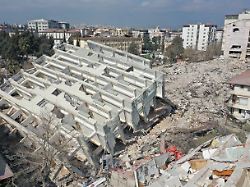Report of Turkish Architects
A striking number of new buildings collapsed
02/24/2023 6:53 p.m
Since an earthquake in the late 1990s, there have actually been stricter building regulations in Turkey. However, a report by the Turkish Chamber of Architects shows that even new buildings were no longer able to offer protection from the most recent quake, which killed more than 43,000 people. They blame the government.
The Turkish Chamber of Architects TMMOB has attested to the government’s great complicity in the extent of the earthquake catastrophe that killed more than 43,000 people in Turkey alone. According to a report by the chamber, the government had put the lives of many people at risk by subsequently legalizing thousands of unauthorized buildings.
Almost half of the buildings in the region affected by the earthquake were built after 2001 – a time when strict building regulations for earthquake safety were already in force. Nevertheless, half of the collapsed or badly damaged buildings are from this period. Construction supervision has been transferred to the private sector, which means that the state has neglected its responsibility for the general public.
With a view to the government’s promise to rebuild the affected regions within a year, the chamber warned that reconstruction should not be carried out under the same premises. According to the government, 164,000 buildings have been registered as collapsed or badly damaged. According to the Chamber of Architects, data from recent years shows that the Toki state housing authority can only build around 58,500 houses a year.
Architects: Active help came too late in many places
The report also criticized again that no help had reached many places for days. In cities in Hatay province, for example, the government and emergency services only began to provide active assistance on the fourth day. In the city of Malatya, for example, the disaster service was active from day one, but was not effective due to a lack of coordination and organization.
The crisis response revealed that the state was massively unprepared. Governors appointed by the government would also have created a chaos of competences and slowed down decisions.
Turkish President Recep Tayyip Erdogan and government officials had rejected such criticism. Erdogan had admitted that there had been problems in the first few days. For example, the government justified bottlenecks in the supply of the crisis regions with the size of the affected area and the severity of the disaster.
